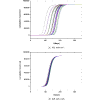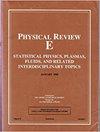Dynamics of a susceptible-infected-recovered model on complex networks with interregional migration
IF 2.4
3区 物理与天体物理
Q1 Mathematics
引用次数: 0
Abstract
We present a susceptible-infected-recovered model based on a dynamic flow network that describes the epidemic process on complex metapopulation networks. This model views population regions as interconnected nodes and describes the evolution of each region using a system of differential equations. The next-generation matrix method is used to derive the global basic reproduction number for three cases: a general network with homogeneous infection rates in all regions, a fully connected network, and a star network with heterogeneous infection and recovery rates. For the homogeneous case, we show that this global basic reproduction number is independent of the migration rates between regions. However, the rate of convergence of each region to an equilibrium state exhibits a much larger variance in random (Erdős-Rényi) networks compared to small-scale (Barabási-Albert) networks. For the general heterogeneous case, we report interesting results, namely that the global basic reproduction number decays exponentially with respect to the smallest nonzero Laplacian eigenvalue (algebraic connectivity). Furthermore, we demonstrate both analytically and numerically that as the network's algebraic connectivity increases, either by increasing the average node degree of each region or the global migration rate, the global basic reproduction number decreases and converges to the ratio of the average local infection rate to the average local recovery rate, meaning that the lower bound of the global basic reproduction rate does not equal the mean of local basic reproduction rates.

具有区域间迁移的复杂网络上的易感-感染-康复模型的动态变化
我们提出了一个基于动态流动网络的易感-感染-恢复模型,该模型描述了复杂元种群网络的流行过程。该模型将种群区域视为相互连接的节点,并使用微分方程系统来描述每个区域的演化过程。我们采用新一代矩阵法推导出三种情况下的全局基本繁殖数:所有区域感染率相同的一般网络、完全连接的网络以及感染率和恢复率不同的星形网络。在同质情况下,我们发现全局基本繁殖数与区域间的迁移率无关。然而,与小规模(巴拉巴西-阿尔伯特)网络相比,在随机(厄尔多斯-雷尼)网络中,每个区域向均衡状态收敛的速率表现出更大的方差。对于一般异质情况,我们报告了有趣的结果,即全局基本繁殖数与最小非零拉普拉奇特征值(代数连接性)呈指数衰减。此外,我们用分析和数值方法证明,随着网络代数连通性的增加,无论是通过增加每个区域的平均节点度,还是通过增加全局迁移率,全局基本繁殖数都会减少,并趋近于平均局部感染率与平均局部恢复率之比,这意味着全局基本繁殖率的下限不等于局部基本繁殖率的平均值。
本文章由计算机程序翻译,如有差异,请以英文原文为准。
求助全文
约1分钟内获得全文
求助全文
来源期刊

Physical review. E
物理-物理:流体与等离子体
CiteScore
4.60
自引率
16.70%
发文量
0
审稿时长
3.3 months
期刊介绍:
Physical Review E (PRE), broad and interdisciplinary in scope, focuses on collective phenomena of many-body systems, with statistical physics and nonlinear dynamics as the central themes of the journal. Physical Review E publishes recent developments in biological and soft matter physics including granular materials, colloids, complex fluids, liquid crystals, and polymers. The journal covers fluid dynamics and plasma physics and includes sections on computational and interdisciplinary physics, for example, complex networks.
 求助内容:
求助内容: 应助结果提醒方式:
应助结果提醒方式:


